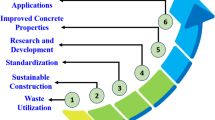Abstract
Due to the urbanization and the need to develop the transportation services, it is inevitable to deal with ground characterized by undesirable geotechnical properties. The problematic soils are divided into swelling soils, collapsible and dispersive soils. The arid to semiarid climate of the Middle East has provided the conditions for the expansion of them. The presence of problematic soils in Iraqi Kurdistan has given rise to many damage to the construction projects of this region. The under-construction road of Gali Ali Bag designed in the vicinity of the Erbil-Haji Omeran highway in Iraqi Kurdistan was faced with pavement settlement and collapse of side slopes due to the passing through the collapsible soils. The presence of collapsible soils in the vicinity of the aforesaid international highway grew concerns about the occurrence of such settlements during its construction. Therefore, how to treat or reduce the collapsibility, especially by the use of practical methods on the site, was addressed as one of the major challenges. In this study, the behavior of treated host soil by four cementitious materials including cement, quicklime, gypsum and NaCl was determined by applying indirect and direct methods. The results show that the addition of 6% quicklime will have the greatest effect on the reduction in collapsibility. After implementing this plan on the site, the collapsibility index decreased by an average of 2.92%.











Similar content being viewed by others
References
Abbeche K, Bahloul O, Ayadat T, Bahloul A (2010) Treatment of collapsible soils by salts using the double consolidation method, Experimental and applied modeling of unsaturated soils. In: Proceedings of sessions of Geoshanghai, Shanghai, China, pp 69–78
Abbeche1 K, Bahloul O, Bahloul A (2016) Study of the influence of the saline solution NaCl on the potential collapse of soil. In: E3S Web of conferences, vol 9. EDP Sciences, p 07001
Basma A, Tuncer ER (1992) Evaluation and control collapsible soils. J Geotech Eng 118(10):1491–1504. https://doi.org/10.1061/(ASCE)0733-9410(1992)118:10(1491)
Houston S, Houston W, Zapata CE, Lawrence C (2001) Geotechnical engineering practice for collapsible soils. In: Toll DG (ed) Unsaturated soil concepts and their application in geotechnical practice. Springer, Dordrecht. https://doi.org/10.1007/978-94-015-9775-3_6
Reznik YM (2007) Influence of physical properties on deformation characteristics of collapsible soils. Eng Geol 92(1–2):27–37. https://doi.org/10.1016/j.enggeo.2007.03.001
Rezaei M, Ajalloeian R, Ghafoori M (2012) Geotechnical properties of problematic soils: emphasis on collapsible cases. Int J Geosci 3:105–110. https://doi.org/10.4236/ijg.2012.31012
Gaaver KE (2012) Geotechnical properties of Egyptian collapsible soils. Alex Eng J 51(3):205–210. https://doi.org/10.1016/j.aej.2012.05.002
Kalantari B (2013) Foundations on collapsible soils: a review. Proc Inst Civ Eng-Forensic Eng 166(2):57–63. https://doi.org/10.1680/feng.12.00016
Fattah MY, Al-Ani M, Al-Lamy M (2014) Studying collapse potential of gypseous soil treated by grouting. Soils Found 54(3):396–404. https://doi.org/10.1016/j.sandf.2014.04.008
Ali NA (2015) Performance of partially replaced collapsible soil—field study. Alex Eng J 54(3):527–532. https://doi.org/10.1016/j.aej.2015.05.002
Ayeldeen M, Negm A, El-Sawwaf M, Kitazume M (2017) Enhancing mechanical behaviors of collapsible soil using two biopolymers. J Rock Mech Geotech Eng 9(2):329–339. https://doi.org/10.1016/j.jrmge.2016.11.007
Rollins KM, Kim J (2010) Dynamic compaction of collapsible soils based on U.S. case histories. J Geotech Geo-environ Eng 136(9):1178–1186. https://doi.org/10.1061/_ASCE_GT.1943-5606.0000331
Daraei A, Herki BMA, Sherwani A, Zare S (2018) Rehabilitation of portal subsidence of Heybat Sultan twin tunnels: selection of shotcrete or geogrid alternatives. Int J Geosynth Ground Eng 4:15. https://doi.org/10.1007/s40891-018-0132-z
Daraei A, Herki BMA, Sherwani A, Zare S (2018) Slope stability in swelling soils using cement grout: a case study. Int J Geosynth Ground Eng 4:10. https://doi.org/10.1007/s40891-018-0127-9
Beiniawski ZT (1989) Engineering rock mass classifications. Wiley, Hoboken
Holtz WG, Hilf JW (1961) Settlement of soil foundation due to saturation. In: Proceedings of the 5th international SMFE, Paris, France, vol 1
Basma AA, Kallas A (2004) Modeling soil collapse by artificial neural networks. Geotech Geol Eng 22(3):427–438. https://doi.org/10.1023/B:GEGE.0000025044.72718.db
Moghadam MJ, Moghadam HA, Rahmannejad R (2006) Urban tunneling in collapsible soil (case study: the Kerman Metro). In: Proceedings of the National Conference on Retrofitting of Iran, Tabriz, Iran
ASTM (2003) Standard test method for measurement of collapse potential of soils. ASTM standard D5333-03, Annual Book of ASTM Standard, Philadelphia
ASTM (2004) Standard test method for measurement of collapse potential of soils. ASTM standard D2435-04, Annual Book of ASTM Standard, West Conshohocken, Philadelphia
Al-Rawas A (2000) State-of-the-art-review of collapsible soils. Sultan Qaboos Univ J Sci [SQUJS] 5:115–135
Daraei R, Herki BMAH, Sherwani A (2017) Study on the rapid drawdown and its effect on portal subsidence of Heybat Sultan twin tunnels in Kurdistan-Iraq. Civ Eng J 3(7):496–507
Acknowledgements
The authors wish to thank Scientific Research Centre (SRC) of Soran University for their assistance during the research and testing procedure.
Author information
Authors and Affiliations
Corresponding author
Rights and permissions
About this article
Cite this article
Daraei, A., Sherwani, A.F.H., Faraj, R.H. et al. Stabilization of problematic soil by utilizing cementitious materials. Innov. Infrastruct. Solut. 4, 33 (2019). https://doi.org/10.1007/s41062-019-0220-5
Received:
Accepted:
Published:
DOI: https://doi.org/10.1007/s41062-019-0220-5




